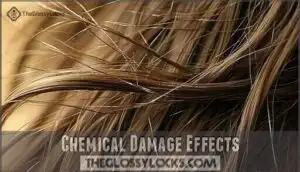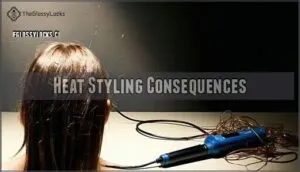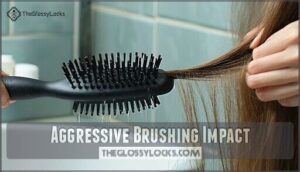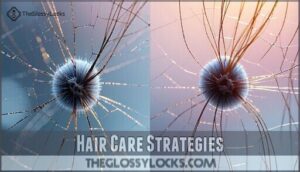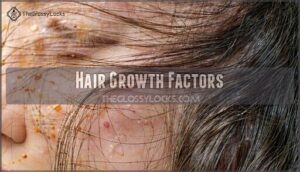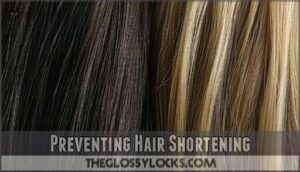This site is supported by our readers. We may earn a commission, at no cost to you, if you purchase through links.
 If your hair feels like it’s shrinking without a haircut, breakage might be the culprit.
If your hair feels like it’s shrinking without a haircut, breakage might be the culprit.
Hair weakens from heat styling, coloring, or even brushing too harshly—making strands snap and appear shorter over time.
Think of it like a rope losing fibers; the length is there, but damage thins it out.
Environmental factors, like sun or pollution, play a role too.
If your ends are splitting faster than your roots are growing, the balance tips, creating that shorter look.
Curious how to stop the cycle? A few smart care strategies can keep your locks growing longer, healthier, and stronger.
Table Of Contents
- Key Takeaways
- Hair Breakage Causes
- Why Hair Gets Shorter
- Hair Care Strategies
- Hair Growth Factors
- Preventing Hair Shortening
- Frequently Asked Questions (FAQs)
- Why is my hair getting shorter and I’m not cutting it?
- Why has my hair gone so short?
- How do you fix stunted hair growth?
- How does air humidity affect hair length and health?
- How does scalp health impact perceived hair length?
- Can water quality influence hair length retention?
- Are specific fabrics causing physical hair damage?
- Does medication intake contribute to hair shortening?
- Conclusion
Key Takeaways
- Your hair might seem shorter due to breakage caused by heat styling, chemical treatments, or rough handling.
- Stress, nutritional deficiencies, and hormonal changes can weaken strands, making growth less noticeable over time.
- Protect your hair by balancing moisture and protein, using gentle care techniques, and minimizing heat or chemical exposure to prevent brittleness.
- Environmental factors like sun, pollution, and water quality can also damage hair, leading to brittleness and breakage.
Hair Breakage Causes
Hair breakage happens when strands weaken and snap due to stress from chemicals, heat, or physical damage.
Hair breakage strikes when your strands face stress from chemicals, heat, or rough handling, leaving them weakened and vulnerable.
Factors like over-processing, frequent heat styling, and rough handling all contribute to visible shortening over time, which can be considered as physical damage.
Chemical Damage Effects
Chemical over-processing wreaks havoc on hair. It damages the cuticle, reducing moisture retention and causing breakage.
Here’s how it happens:
- Cuticle damage weakens hair elasticity and increases porosity.
- Protein loss depletes hair strength, leading to hair damage.
- Harsh dyes and bleach trigger hair breakage.
- Overuse of relaxers causes chemical burns, worsening damage.
Opt for color correction and gentle treatments to repair damaged hair. Addressing nutritional deficiencies impact can also help strengthen hair, reducing the risk of hair breakage and promoting hair strength.
Heat Styling Consequences
Heat styling tools, while handy for sleek looks, can wreak havoc on your hair.
Excessive heat weakens strands, causing split ends and hair breakage. Using high tool temperatures repeatedly strips moisture, leaving hair dry and brittle.
You can prevent heat damage with specialized protective products.
Minimize damage by reducing styling frequency, applying heat protectants, and repairing damage with nourishing masks. Smart precautions protect against long-term hair damage and promote healthy hair.
Aggressive Brushing Impact
If you’re too rough with a brush, your hair can snap like dry spaghetti, leading to breakage and thinning.
To protect your strands:
- Use a wide-tooth comb for gentle detangling.
- Brush only when hair is dry to preserve elasticity.
- Choose soft-bristle tools for better tool selection.
- Start detangling at the ends, working upward to prevent shedding, which helps prevent shedding.
Environmental Factors Influence
Harsh weather isn’t doing your hair any favors.
Sun exposure makes it dry, while salt water and air pollution weaken strands.
Seasonal changes can leave hair brittle, prone to split ends, and breakage.
Use this quick cheat sheet:
| Factor | Impact on Hair | Hair Damage Prevention |
|---|---|---|
| Sun Exposure | Dries and weakens | Wear hats, apply UV sprays |
| Salt Water | Strips moisture | Rinse, use leave-in conditioner |
| Air Pollution | Weakens follicles | Wash regularly, moisturize |
To prevent hair damage, follow the guidelines in the cheat sheet, and take extra care to protect your hair from harsh weather conditions.
Why Hair Gets Shorter
Your hair might be getting shorter for various reasons.
Frequent breakage, stress, and damage are silent culprits shortening your hair—nurture it for lasting length and resilience.
One common factor is frequent breakage caused by heat styling, rough brushing, or chemical treatments, which snap strands before they can grow longer.
Growth cycle disruptions, often linked to stress, hormonal shifts, or age-related changes, can shorten the time hair spends growing.
Hair shedding or thinning driven by nutritional deficiencies, illness, or even tight hairstyles makes it feel like your locks are in retreat.
Environmental damage, such as sun exposure or saltwater, weakens strands over time.
Sometimes, the culprit is simply age—hair grows slower and becomes more fragile as you get older.
Understanding these shorter hair causes helps you pinpoint external damage factors and find realistic solutions for maintaining length.
Lifestyle factors, such as stress, can also contribute to thinning, and recognizing hair shedding patterns is crucial for effective hair care.
Hair Care Strategies
Taking care of your hair can stop breakage and help it grow to its full potential.
Simple changes like regular trims, easing up on heat styling, and choosing gentler treatments can make a big difference in preserving length.
Regular Trims Importance
Regular trims are a preventative hair care essential, acting as your split end removal tool and length retention strategy.
By snipping damaged ends every 6-8 weeks, you stop hair breakage before it spreads.
Think of it as a refresh for hair health maintenance. A trim frequency guide for consistent care promotes healthier hair trimming habits, keeping your strands strong and resilient.
Reducing Heat Exposure
Skip daily heat styling to limit hair breakage and split ends.
Opt for air drying or heatless styling methods instead of relying on high heat tools.
If you can’t avoid heat styling, use these tips:
- Lower temperatures on tools to minimize damage.
- Apply heat protectants for better hair protection.
- A good strategy involves using quality heat protectant before styling.
- Use a diffuser to reduce direct heat exposure.
Chemical Treatment Alternatives
Chemical-free alternatives like keratin smoothing and hair Botox can transform your hair without the harsh effects of traditional treatments.
Natural solutions, such as herbal hair care, oil treatments, and DIY conditioners, nourish strands while reducing hair breakage and damage.
Here’s a helpful comparison of alternatives:
| Treatment | Benefits | Risks | Duration |
|---|---|---|---|
| Keratin Treatment | Smoothing, shine | Potential weakening | 3-5 months |
| Hair Botox | Deep repair, no chemicals | Temporary effects | 2-4 months |
| Oil Treatments | Hydration, strengthening | Greasiness if overused | Variable |
| Natural Hair Dyes | Gentle color change | Limited color options | Semi-permanent |
Protective Styling Methods
Protective styling, like braids or twists, minimizes everyday hair fuss while promoting scalp health and style longevity.
Choose low manipulation options to reduce hair breakage, balancing tension control with comfort.
The right product choice, like hydrating leave-ins, helps protect strands.
Consider specialized styling products for best results.
Focus on hair care habits that prevent stress on roots, aiding hair length retention and overall hair health.
Hair Growth Factors
Your hair’s growth depends on a mix of genetic, nutritional, hormonal, and lifestyle factors, each playing a vital role in its length and health.
Understanding these influences can help you address issues and promote stronger, longer hair.
Genetic Influence on Growth
Genetics set the foundation for your hair’s potential.
Your growth cycle length and maximum hair length are genetically determined, varying by individual.
Each hair strand grows and sheds independently, creating a normal shedding rate.
If your hair type favors shorter cycles, growth may seem sluggish.
Remember, hair length depends less on effort and more on nature’s blueprint.
Nutritional Deficiencies Impact
If your hair feels thinner or falls out more often, nutritional deficiencies might be the culprit.
Missing key vitamins like biotin or minerals like iron impacts hair growth and strength.
Skipping protein in your meals? That can lead to weaker strands.
Diet changes, supplement options, and prioritizing hair vitamins can tackle hair thinning or loss effectively.
Hormonal Imbalances Effects
Sometimes your hair feels like it’s got a secret agenda, right?
Hormonal imbalances, like those from thyroid disorders or menopause effects, can disrupt your hair growth cycle.
Stress hormones and autoimmune impact may trigger hair thinning or unexpected hair shedding.
Even subtle nutritional links contribute to hair loss.
Balancing your hormones might just restore healthier, stronger strands, and improve your overall hair health by addressing the underlying causes of hair loss, such as hormonal imbalances.
Stress Management Techniques
Stress can mess with your hair’s rhythm, making it shed more than it should. Try relaxing with simple steps like mindful breathing or a walk in fresh air.
Also, balance your habits for better mental health and hair growth:
- Prioritize sleep for hormonal balance.
- Eat a nutrient-rich, balanced diet.
- Practice daily relaxation methods like yoga.
- Stay active to reduce stress naturally.
To combat this, consider stress reduction strategies to help minimize shedding and improve your overall mental health with stress reduction.
Preventing Hair Shortening
You can prevent hair shortening by focusing on gentle care techniques that protect your strands from damage.
Balancing moisture and protein, reducing stress on your hair, and avoiding harsh treatments can help maintain its health and length.
Balancing Moisture and Protein
Finding the right balance between hair protein and hair moisture is essential for hair strength and elasticity.
Too much moisture can lead to limp strands, while excess protein causes hair breakage. Recognizing imbalance signs, like fragile or brittle hair, helps guide treatment frequency.
Lifestyle choices such as stress management techniques can also impact hair health. Choose products labeled "restoring" or "strengthening" and adapt based on your hair’s changing needs.
Reducing Hair Washing Frequency
Too frequent washing strips natural scalp oil production, leaving strands vulnerable to hair dryness and damage.
To ease into a healthier hair care routine, try shampoo alternatives like co-washing or dry shampoo use.
Washday extenders help maintain hydration importance while reducing hair damage repair needs.
Spacing washes promotes balanced hair maintenance and reduces the risk of over-cleansing.
Nighttime Hair Protection Tips
Protecting your hair overnight prevents unnecessary breakage and supports hair health.
Use these tips to keep strands strong while you sleep:
- Wrap your hair in a silk scarf or satin bonnet to minimize friction.
- Switch to a silk or satin pillowcase for better hair maintenance.
- Try the pineappling method or loose braiding to reduce tangling and promote hair protection.
Embracing Natural Hair Texture Benefits
Embracing your natural hair texture is a game-changer.
It boosts texture definition, enhances volume, and reduces damage caused by constant heat or chemicals.
With less stress on your strands, you’ll save time and money on styling products.
Understanding your hair porosity helps fine-tune care, while innovative hair styling techniques offer versatility without overloading your routine.
Shrinkage? It’s just curls’ charm!
Frequently Asked Questions (FAQs)
Why is my hair getting shorter and I’m not cutting it?
Your hair may seem shorter due to breakage from heat styling, harsh treatments, or tight hairstyles.
Factors like hormonal changes, nutritional deficiencies, or stress can also weaken strands, causing snapping and making growth less noticeable, which can be affected by hormonal changes.
Why has my hair gone so short?
It’s not magic; your hair might be breaking due to over-styling, dryness, or even stress.
Chemical processing, nutritional gaps, and tight hairstyles also weaken strands.
Address these factors to regain your hair’s health.
How do you fix stunted hair growth?
Focus on a nutrient-rich diet with protein and vitamins, minimize heat styling, and treat your scalp gently.
Regular trims prevent split ends, while hydrating products and stress management create the ideal foundation for hair growth.
How does air humidity affect hair length and health?
Humidity can make your hair swell, causing it to appear shorter as curls or frizz form.
Excess moisture affects the hair cuticle, leading to increased brittleness over time if not managed with proper care.
How does scalp health impact perceived hair length?
Imagine your scalp as fertile soil for a garden—if it’s unhealthy, hair struggles to thrive.
Issues like buildup, dryness, or poor circulation weaken strands at the roots, making hair appear thinner, weaker, and shorter, due to poor circulation.
Can water quality influence hair length retention?
Hard water, packed with minerals like calcium and magnesium, can weaken your hair, making it more prone to breakage.
It can also leave behind residue, blocking moisture absorption and making hair feel dry and brittle.
Are specific fabrics causing physical hair damage?
Sometimes, certain fabrics can damage hair physically.
Cotton pillowcases, wool hats, or rough scarves create friction and lead to breakage.
Switch to silk or satin materials for smoother surfaces that protect your strands from harm.
Does medication intake contribute to hair shortening?
Certain medications can disrupt your hair’s growth cycle, causing strands to shed prematurely or grow weaker.
Chemotherapy, hormone therapies, and some antidepressants are common culprits.
Talk with your doctor if you notice significant changes.
Conclusion
Picture your hair as a delicate fabric—constant wear without care frays the edges.
If you’re wondering, "Why is my hair getting shorter without cutting it?" breakage is likely the answer.
Prevent damage by balancing moisture and protein, skipping harsh heat tools, and shielding strands from the environment.
Small steps, like gentle brushing or nighttime protection, can yield big results.
Treat your hair with patience and consistency, and its strength, length, and health can flourish over time.
- https://www.healthline.com/health/thinning-hair
- https://www.health.harvard.edu/blog/thinning-hair-in-women-why-it-happens-and-what-helps-2020032719267
- https://www.whimn.com.au/look/beauty/kate-middleton-just-debuted-your-next-haircut/news-story/1ad3cdbec8031b83a72ba96ea14cb648
- http://mailto:help
- https://www.naturallycurly.com/curlreading/wavy-hair-type-2/6-reasons-your-hair-wont-grow

